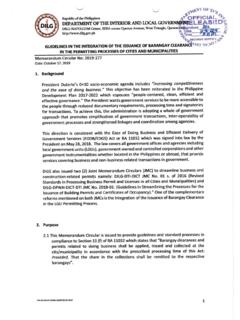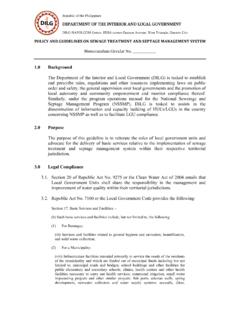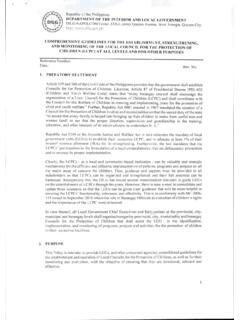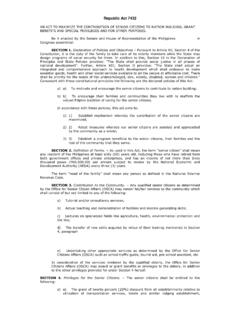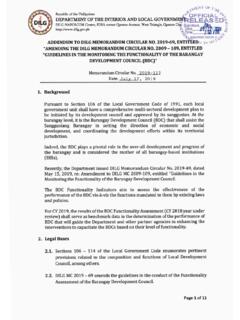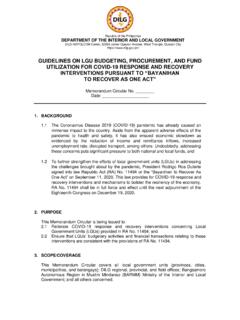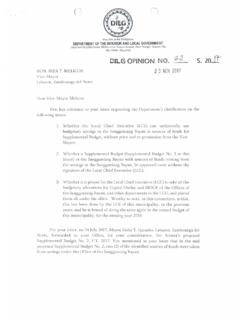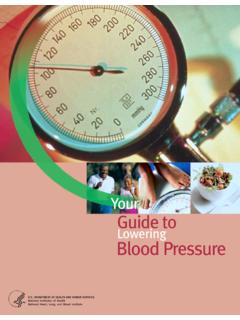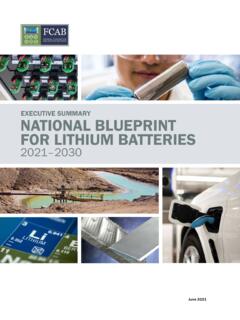Transcription of The National Disaster Risk Reduction and Management Plan
1 1 | Page 2011 to 2028 FINAL VERSION December 2011 The National Disaster Risk Reduction and Management plan NDRRMP 2 | Page TABLE OF CONTENTS Page Numbers Abbreviations Executive Summary I. Risk Profile and State of DRRM in the Philippines 8 -- 13 Risk Profile Progress on the Implementation of the HFA and SNAP for DRR 2009-2019 Lessons learned and gaps identified Republic Act 10121 II. Development Policies, Challenges and Opportunities 13 -- 17 Philippine Development plan National Climate Change Adaptation Action plan National Security plan National DRRM Framework III.
2 The National DRRM plan 17 -- 38 DRRM priorities areas and long term goals Disaster Prevention and Mitigation Disaster Preparedness Disaster Response Rehabilitation and Recovery Priority Projects Cross Cutting Concerns General Considerations and Planning Assumptions Timelines Implementation Strategies and Mechanisms Agency Leads and Implementing Partners Resource Mobilization Monitoring, Evaluation and Learning IV. Annex 39 -- 68 A -- Development of the NDRRMP B -- Definition of Terms C -- Detailed NDRRMP D -- The PDP and the NDRRMP E -- The NCCAAP and the NDRRMP F -- The HFA and the NDRRMP G Monitoring and Evaluation 3 | Page Accronyms and Abbreviations CCA Climate Change Adaptation CCC Climate Change Commission CDRRMC City Disaster Risk Reduction and Management Council CHED Commission on higher education DA Department of Agriculture DAR Department of Agrarian Reform DENR Department of Environment and Natural Resources DepED Department
3 Of education DILG Department of Interior and Local Government DOE Department of Energy DOF Department of Finance DOH Department of Health DOLE Department of Labor and Employment DOST Department of Science and Technology DPWH Department of Public Works and Highways DRR Disaster Risk Reduction DRRM Disaster Risk Reduction and Management DSWD Department of Social Welfare and Development DTI Department of Trade and Industry GDP Gross Domestic Product HFA Hyogo Framework for Action HUDCC Housing and Urban Development Coordinating Council IEC Information, Eduction and Communication LDRRMF Local Disaster Risk Reduction and Management Fund LDRRMO Local Disaster Risk Reduction and Management Office LGUs Local Government Units LWUA Local Water Utilities Administration MDG Millenium Development Goals MDRRMC Municipal Disaster Risk Reduction and Management Council MILF Moro Islamic Liberation Front NCCAP Nationa Climate Change Action plan NDRRMC National Disaster Risk Reduction and Management Council NDRRMF National Disaster Risk Reduction and Management Fund NEDA National Economic and Development
4 Authority PAGASA Philippine Atmospheric, Geophysical and Astronomical Services Administration PAR Philippine Area of Responsibility PDP Philippine Development plan PDRRMC Provincial Disaster Risk Reduction and Management Council PHIVOLCS Philippine Institute of Volcanology and Seismology PIA Philippine Information Agency PPP Public-Private Partnership RDRRMC Regional Disaster Risk Reduction and Management Council TESDA Technical education and Skills Development Authority UNISDR United Nations International Strategy for Disaster Reduction 4 | Page 5 | Page EXECUTIVE SUMMARY The
5 Enactment of Republic Act 10121 otherwise known as the Philippine Disaster Risk Reduction and Management Act of 2010 has laid the basis for a paradigm shift from just Disaster preparedness and response to Disaster risk Reduction and Management (DRRM).The National DRRM plan serves as the National guide on how sustainable development can be achieved through inclusive growth while building the adaptive capacities of communities; increasing the resilience of vulnerable sectors; and optimizing Disaster mitigation opportunities with the end in view of promoting people s welfare and security towards gender-responsive and rights-based sustainable development.
6 Over the past several years, the country has gained a lot of attention and momentum in the area of Disaster risk Reduction . Numerous projects and activities have been undertaken by various Philippine stakeholders and agencies in DRRM. However, sustaining the positive results and scaling them up to effect rippling positive changes in the lives of the poeple have been constant challenges. Threats remain. Disasters and people s risk to disasters are still present. This is because the underlying causes of people s vulnerability has yet to be fully fully recognized and addressed.
7 For years, DRR has focused more on efforts around Disaster preparedness and response and not so much in identifying the hazard-prone areas and other factors which contribute to people s exposure to disasters; incorporating risk analysis to development plans; building people s capacities towards sustainable livelihood options; and the like. Although DRR has been gaining attention among peoples and institutions, complete paradigm shift from disasters as an immediate product of hazards to disasters as a function of people s vulnerability has not yet fully happened.
8 Also, converging DRR and CCA remains to be a challenge, both in understading, mainstreaming into plans and policies, including institutional mechanisms. Lastly, gaps in terms of increased knowledge, understanding and capacities remain and cause a big challenge for the country in terms of DRRM. The NDRRMP outlines the activities aimed at strengthening the capacity of the National government and the local government units (LGUs) together with partner stakeholders, to build the Disaster resilience of communities and to institutionalize arrangements and measures for reducing Disaster risks, including projected climate risks and enhancing Disaster preparedness and response capabilities at all levels.
9 It highlights, among others, the importance of mainstream DRRM and CCA in the development processes such as policy formulation, socioeconoimc development planning, budgeting and governance particularly in the area of environment, agriculture, water, energy, health, education , poverty Reduction , land-use and urban planning and public infrastructure and housing among others. Mainstreaming also puts to forth the need to develop common tools to analyze the various hazards and vulnerability factors which put our communities and people into harms way.
10 The NDRRMP also highlights the need for institutionalizing DRRM policies, structures, coordination mechanisms and programs with continuing budget appropriation on DRR from National down to local levels. Through permanent mechanisms, competency and science-based capacity building activities can be done, alongside the nurturing of continuous learning through knowledge development and Management of good DRRM practices on the ground. Last but not least, the NDRRMP adheres to the principles of good governance within the context of poverty alleviation and environmental protection.

